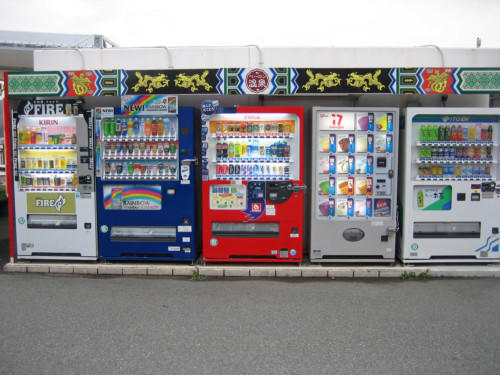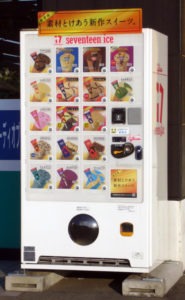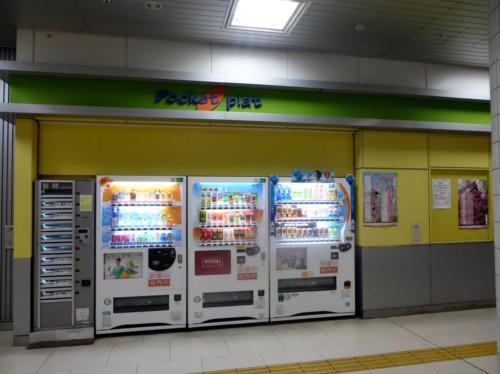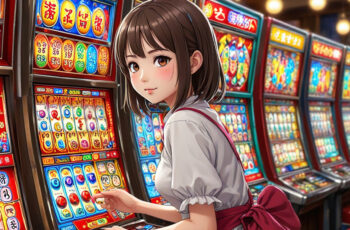
Beyond panties and bras, vending machines in Japan dispense a staggering variety of products: frozen beef, hamburgers, soft drinks, eggs, cigarettes, alcohol, ice cream, soup, porn, towels, flowers, bus tickets, train tickets, toys, batteries, coffee, DVDs, and even dates…the kind that involves people, not the fruit.
Back in 1993, there were 50 machines in every square kilometer (Minshall, 1993). In 1998, Japan had over 5.4 million vending machines (Mak, 1998).
Who invented the first vending machine is up for debate. In 1867, the German Carl Ade is believed to claim the first patent. But in 1888, Yoshiichi Tawaraya was said to produce the first automatic vending machine (Minshall, 1993). In either case, Japan took the idea and ran with it.
Why Were Vending Machines so Popular in Japan?
Japan loved vending machines for many reasons. Convenience dominates these reasons. Etiquette rules Japanese society. Many people get tired of obligated small talk and social requirements. Vending machines let you avoid that.
“Because of traditional attitudes it can be psychologically awkward to walk into a shop to buy something small, like a pack of cigarettes, and just leave.” (Sterngold, 1992)

Busy people can use them instead of pressuring the culture to drop traditional etiquette. Busyness can’t be underestimated as a changing force. Japanese workers put in long hours, often off the clock. Vending machines allow people to circumvent cultural expectations in other ways too. They help people avoid social embarrassment associated with buying certain products. For example, in the 1990s flower machines allowed young men to avoid the embarrassment of admitting to shopkeepers they were buying a nice gift for a sweetheart. Such a gesture of affection was unusual in Japan for the time and rather embarrassing (Sterngold, 1992).
Vending machines soon developed a wide variety of products to accommodate long work hours and avoid the embarrassment of trying to placate a wife a salary-man rarely sees. Even better for the customer, prices between different machines remained the same. On the business side, vending machines save on overhead. Land and labor in Japan cost a bundle. Vending machines produce more revenue for each square meter of space compared to a retail store (Mak, 1998). Competition zeroes in on location. Because product prices remain the same, vendors seek the best locations for their product selection. Volume creates profit, so the best locations in the busiest areas yield the best profit. Vending machines encourage impulse buying and immediate need. That is why underwear machines are found in saunas (Sterngold, 1992).
Japan’s low crime rate helps. Businesses can place machines all over and not worry about vandalism (Mak, 1998). Here in the US, we place vending machines in front of established businesses because of the real threat of vandalism. You will rarely see a vending machine standing alone in a street. In Japan, vending machines appear nearly anywhere.Vendors need to place their machines where the consumers need them to maximize impulse buying. Even if this means the machine stands along on a hiking path in the middle of a forest (selling insect repellent, of course). Access to electricity limits placement more than anything.
Finally, vending machines have return policies. People can fill out a form (paper back in the day) if a machine ate your money, and the product was delivered to you (Minshall 1993).
Weird Vending Machines

Back in the 90’s vending machines peddled dates for those who lack time to meet people. Remember, this was before online dating. Japanese men would submit an application with a photo including information about their blood types, height and weight, astrological sign, and job. Guys paid $40 to make 30 copies of their forms destined to be randomly placed in 30 “Happy Guy” vending machines around Tokyo. Women put in $2 to receive the info (Thornton, 1992).
In 2013, a bra vending machine debuted, but it sold few. The bras it sold cost 3,000 yen — about $30.
Used Panty Vending Machines

Vending machines that sell underwear worn by teens are one of those stories that refuses to die. These machines did exist in Tokyo, but they were never a common way of buying such (Waterstreet, 2014). The whole thing started back in the 1990s during a teen school-girl craze that swept through parts of Japan. It rode on the waves of the exploding j-pop idol movement. Worn school uniforms and underwear were sold in specialty adult stores (Ashcraft, 2012). School girls would sell their clothes to these shops. This didn’t last long. Japan’s health departments cracked down, and the practice became illegal. But new underwear can still be sold.
The underwear fetish still survives, just like the urban legend of worn-panty machines.
As you’ve seen, the 1990s were something of a golden age for vending machines. I don’t know about you, but I wouldn’t mind some Japanese style vending machines here in the States. No, I don’t mean the panty-machines. The ability to buy little things like batteries and other odds without fighting checkout lines would be great! But the US has a lot more theft and vandalism than Japan, so I don’t see this ever happening. What would you like to see in a vending machine?
References
Ashcraft, B (2012). Japan’s Panty Vending Machines: The Unreal Hyperbole (and Honest Truth). Kotaku. http://kotaku.com/5948143/japans-panty-vending-machines-the-unreal-hyperbole-and-honest-truth
Mak, James (1998), “Why is Japan a Paradise of Vending Machines?” Japan — Why it Works, Why it Doesn’t: Economics in Everyday Life. University of Hawaii Press.
Minshall, Tim (1993) A Paradise of Automation. New Scientist. 140 (1893), 61-62.
Sterngold, James (1992) “Why the Japanese Adore Vending Machines. The New York Times.
Thornton, E. (1992). Japan’s New Cupid: Vending Machines. Fortune, 125(7), 13.
UPI (2013) Bra Vending Machine attracts few customers in Osaka, Japan.
Waterstreet, C (2014). Vending Machines Reveal Tolerance of Abuse. The Sun-Herald. 34



